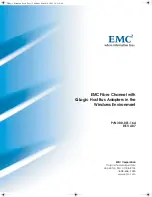
Best practices
This sections provides some “best practices” recommendations for DMS usage.
Migration considerations
Although this appendix focuses on the migration functionality available with the MPX200, it is important
to note that a successful migration strategy includes a thorough understanding of the processes that
should be considered before and after physically moving data.
In fact, the physical movement of the data will probably take the least amount of time in the overall
migration process. The pre- and post-migration activities determine the success of any migration
project.
This section cannot detail all available information on the pre- and post-migration processes, but there
are books and websites dedicated to helping you with migration planning and should be consulted
prior to any physical movement of data.
Pre-migration
Consider the following before performing data movement:
•
Project Impact Assessment.
This could be thought of as a feasibility study or risk assessment to
help determine, for example, the cost, technology requirements, personnel, and the time it will
take to complete the migration project.
•
Partnering with Other Departments.
It is likely that other groups within the company need to be
consulted or tied in with the migration process prior to any data movement.
•
Security Restrictions.
Consider the security impact of moving the data. There may be company
policies and procedures that need to be taken into account.
•
Data Integrity Checks.
Address data quality issues prior to any migration. This will help determine
the success of the migration project. Bad data before the migration will be there after the migration.
•
Detailed Mapping Design.
A comprehensive document that shows the mapping of LUNs before
and after data migration can keep the right data with the right application.
•
Migration Failback Policy.
Have a contingency process in place in the event it becomes necessary
to revert to the original configuration.
Post-migration
Consider the following after the data movement:
•
Data Validation.
Ensure that the migration process has delivered the data to a sufficient quality
level to support the target services.
•
Security Validation.
Ensure that the migration process adheres to your company's security policies.
•
Migration Audit.
You may need to demonstrate to the business sponsors and independent auditors
that your migration is compliant with company, state, or federal regulations.
•
Migration Signoff.
If other departments or business units are involved, it may be necessary for
them to agree that the data migration was successful.
High availability and redundant configurations
Consider the following recommendations:
•
To maximize performance, zone each MPX200 Fibre Channel port with one or two ports from
one of the array controllers.
Offline Data Migration
146
Summary of Contents for Storageworks 8100 - enterprise virtual array
Page 20: ...20 ...
Page 30: ...MPX200 Multifunction Router overview 30 ...
Page 47: ...Figure 27 iSCSI controller options Remove controller MPX200 Multifunction Router 47 ...
Page 48: ...Managing the MPX200 using HP Command View EVA 48 ...
Page 59: ...Figure 32 Virtual disk properties Figure 33 Host details MPX200 Multifunction Router 59 ...
Page 112: ...MPX200 iSCSI configuration rules and guidelines 112 ...
Page 219: ...Load Balancing Enabled Array License Not Applied MPX200 Multifunction Router 219 ...
Page 248: ...Offline Data Migration 248 ...
Page 258: ...Diagnostics and troubleshooting 258 ...
Page 306: ...Command referencecommand reference 306 ...
Page 330: ... Blade number 1 or 2 Simple Network Management Protocol setup 330 ...
Page 368: ...Saving and restoring the MPX200 configuration 368 ...
Page 402: ...Data migration best practices 402 ...
Page 408: ...408 ...
















































